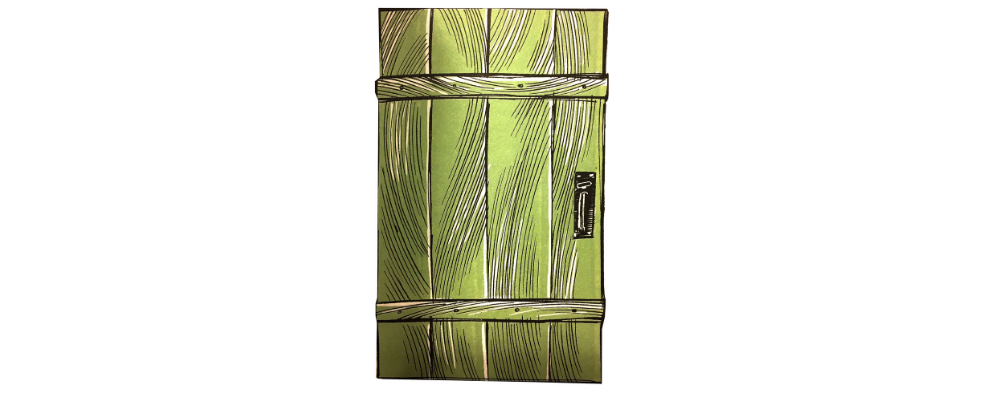The Sekoyana's Gates is a "story of forest" written by Şiirsel Taş. The story begins with a child being entrusted to Sekoyana, who lives a reclusive life in his own cottage, for a period of time.
The Sekoyana's Gates is a "story of forest" written by Şiirsel Taş. The story begins with a child being entrusted to Sekoyana, who lives a reclusive life in his own cottage, for a period of time. But the child quickly realizes that this world is a totally foreign to him. When standing silently in the face of a kid with his long hair which he says it has been getting green while he grows, the child tries to tell his name to Sekoyana in order to disrupt the uncomfortable silence and, of course, to introduce in his own way. However, Sekoyana interrupts the child and says, "You have no name to say!" (Taş 8). From this point onwards, the child and the reader are thrown from a four-door cottage in an unknown world to a forest adventure on the way to find the name of the child.
The rule is simple. The child will exit from all the doors of the cottage one by one, and is free to exit from the door of his choice, but he has to exit the same door until he believes that he is done with that door. The child hereby meets a different side of the forest at the exit of each door. He meets with earth at the first door, at the second door with air, at the third door with water, and lastly with fire due to his illness. After each meeting, that is, in the passage to another door, it is required from him to draw something impressive to him on the previous door, something related to what he has experienced since leaving that door. He draws a question mark on the first door. Because at the end of the first three days in the forest, there were question marks in his mind. Uncertainty about the forest and the lives there scares him. At this point, the forest appears as a mystic space, with the harmony, which was created by a dialog linking everything in the forest and the rules that work in itself. Sekoyana's diary, which was put into the story by interrupting it, constantly underlines this dialog.
Like mycorrhiza, the communication system of trees, the forest and everything in it is in a vivid communication. It is also a part of this dialog that a wildcat leads Sekoyana to find the child who faints in the midst of heavy rain, as well as a red deer, who carries the child to the cottage on the same day, accompanies them. As long as the child lives in the forest he gradually approaches to the language of the forest and becomes part of this dialogue. As far as he becomes part of it the mysterious elements of the forest and so the question marks, will also differentiate for the child. This change, of course, happens with Sekoyana, a mystical wise man having the knowledge of the forest. Sekoyana teaches the child communicating with trees, soil, and all the elements related to them by using his senses as well as feeling them. Therefore, after each gate the child stops taking only the side of his own kind, as Sekoyana puts it and turns into a "three-legged forest creature" with his long wand, which allows him to easily cross the hills. The forest is no longer a foreign place for the child.
However, the child still has question marks. He draws what impresses him to each door, and what he has drawn is what he cannot understand about the forest. But these question marks are different from the initial ones; because the way the child thinks about the language of the forest begins to change. The truth of the forest is different than the truth of the everyday urban life. Even if the child gets closer to the language of this reality, the unknown part does not frighten the child anymore, though it still persists. In the first place, the child produces various stories about a glade that he encounters on an exploration trip in the forest. There is a big question mark as to why there is a space where there is no tree, and how the lawns are laid around a smooth circle around it. At first, he thinks that the glade is a trace done by a flying saucer. Sekoyana explains that this place called the witch circle. Since the witches are mysterious and creepy, the child does not want to believe in this. However, Sekoyana reverses the story. The witches boil things in the boilers, which give the smell of the forest itself, in the center of the glades. Other creatures cannot see them; because the forest makes the witches, who enter the forest, invisible and protect them. Sekoyana is a witch who is integrated with the forest with its green hair and protects the child. After this point, mysterious events continue to be mysterious, but they do not scare the child anymore. The sounds that the child hears when he leaves the doors are not of the people but of the amber whistle, which allows the forest to hear things and allows the wildcat to find the child when he was about to die. These things and the hair of Sekoyana are the elements of the forest's own reality. Sekoyana is in the forest to approach this truth, to read the language of the forest and to be a part of it. The child was entrusted to Sekoyana to learn this language. After that point, everyone who approaches the forest language like the child will immediately notice how the sky and the ocean, the stigma and the fish resemble each other. Because the story suggests that the essence of all of them is one thing; however people are alienated from it over time.
In fact; this life, in which Sekoyana lives together with children, who are left in the middle of the forest, is a civil disobedience. At this point, it is also useful to remember that the child is actually together with Sekoyana to find his own name. It is necessary for him to see another reality rather than accepting the name given to him, to understand that the only life he lives is not the life imposed on the city, and to find his own name in the world of the forest in which the reality of his previous life was destroyed. As his way of thinking begins to change, he begins to get the distant from the urban life well. Old meanings change and new meanings emerge just like the one about the witch story on the glade. This is a resistance, a passive one, against the modern world, which has gradually diverged from the forest and suppressed its voice. Because the main principle here is not to harm. For this reason, the word ahimsa, which means simply not to harm, holds a very important place in the text. At this point, it is possible to establish a parallelism between the forest story of Sekoyana and the salt march of Gandhi acting on the ground of the ahimsa principle. Gandhi marched thousands of miles to the sea with the support of thousands of people to protest the salt tax and break the monopoly on it. He took salt mixed with mud from the sea, washed it, and produced his own salt, thus broke the rules on the boundaries of the uniformed ahimsa principle. Sekoyana rebels in his cottage he has built himself, with the bread he makes with his own flour and with the food he prepares with his own gathering. It is also the fundamental principle for him not to harm anybody in this resistance. Hunting is a violent phenomenon in his eyes, and therefore, Sekoyana is not a hunter but a collector. The music heard throughout the text is also related to this principle. Sekoyana constantly mumbles a song, which was sung in old languages. The most remarkable thing for the child is the word ahimsa, which is constantly passing through the song and he will learn its meaning later. The name the child chooses for himself at the end of the story will also be this word, ahimsa.
To summarize, The Sekoyana's Gates is a narrative of forest that constantly gets distant to this life, questioning it, and suggesting another way of life instead. Through the forest adventure of the child coming to Sekoyana, who has access to the knowledge of the forest, the unknown parts of the forest changes shape and opens the gates of a different reality. Discovering the possibilities of existence of another life on a regular basis will now pave the way to a disobedience to the previous life and a resistance against it. The main principle of this new way is not to cause harm. The child chooses this principle as his name and leaves the forest. He goes back to the city not as the person he arrived at the forest, but as a three-legged forest creature. Thus, this passive resistance has exceeded the forest and carried itself to the continuing life.
Bibliography
Taş, Şiirsel. Sekoyana’nın Kapıları: Bir Orman Öyküsü. Res. Oğuz Demir. İstanbul: Doğan Egmont
Yayınları, 2017.

